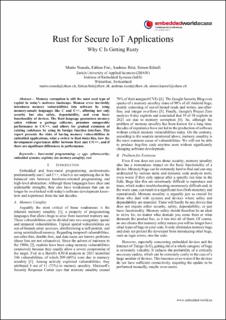Please use this identifier to cite or link to this item:
https://doi.org/10.21256/zhaw-25046Full metadata record
| DC Field | Value | Language |
|---|---|---|
| dc.contributor.author | Noseda, Mario | - |
| dc.contributor.author | Frei, Fabian | - |
| dc.contributor.author | Rüst, Andreas | - |
| dc.contributor.author | Künzli, Simon | - |
| dc.date.accessioned | 2022-05-30T14:23:46Z | - |
| dc.date.available | 2022-05-30T14:23:46Z | - |
| dc.date.issued | 2022-06 | - |
| dc.identifier.uri | https://digitalcollection.zhaw.ch/handle/11475/25046 | - |
| dc.description.abstract | Memory corruption is still the most used type of exploit in today’s malware landscape. Human error inevitably introduces memory vulnerabilities into software by using memory-unsafe languages like C and C++, affecting not only security but also safety, dependability, and even basic functionality of devices. The Rust language guarantees memory safety without a garbage collector, promises comparable performance to C/C++, and allows for gradual extension of existing codebases by using its foreign function interface. This report presents the risks of having memory vulnerabilities in embedded applications, what a switch to Rust looks like, how the development experiences differ between Rust and C/C++, and if there are significant differences in performance. | de_CH |
| dc.language.iso | en | de_CH |
| dc.publisher | WEKA | de_CH |
| dc.rights | Licence according to publishing contract | de_CH |
| dc.subject | Bare-metal programming | de_CH |
| dc.subject | C | de_CH |
| dc.subject | CPP | de_CH |
| dc.subject | Cybersecurity | de_CH |
| dc.subject | Embedded system | de_CH |
| dc.subject | Exploit | de_CH |
| dc.subject | IoT | de_CH |
| dc.subject | Memory unsafety | de_CH |
| dc.subject | Rust | de_CH |
| dc.subject.ddc | 005: Computerprogrammierung, Programme und Daten | de_CH |
| dc.title | Rust for secure IoT applications : why C is getting rusty | de_CH |
| dc.type | Konferenz: Paper | de_CH |
| dcterms.type | Text | de_CH |
| zhaw.departement | School of Engineering | de_CH |
| zhaw.organisationalunit | Institute of Embedded Systems (InES) | de_CH |
| dc.identifier.doi | 10.21256/zhaw-25046 | - |
| zhaw.conference.details | Embedded World Conference, Nuremberg, Germany, 21-23 June 2022 | de_CH |
| zhaw.funding.eu | No | de_CH |
| zhaw.originated.zhaw | Yes | de_CH |
| zhaw.publication.status | publishedVersion | de_CH |
| zhaw.publication.review | Peer review (Abstract) | de_CH |
| zhaw.author.additional | No | de_CH |
| zhaw.display.portrait | Yes | de_CH |
| Appears in collections: | Publikationen School of Engineering | |
Files in This Item:
| File | Description | Size | Format | |
|---|---|---|---|---|
| 2022_Noseda-etal_Rust-for-secure-IoT-applications.pdf | 454.63 kB | Adobe PDF |  View/Open |
Show simple item record
Noseda, M., Frei, F., Rüst, A., & Künzli, S. (2022, June). Rust for secure IoT applications : why C is getting rusty. Embedded World Conference, Nuremberg, Germany, 21-23 June 2022. https://doi.org/10.21256/zhaw-25046
Noseda, M. et al. (2022) ‘Rust for secure IoT applications : why C is getting rusty’, in Embedded World Conference, Nuremberg, Germany, 21-23 June 2022. WEKA. Available at: https://doi.org/10.21256/zhaw-25046.
M. Noseda, F. Frei, A. Rüst, and S. Künzli, “Rust for secure IoT applications : why C is getting rusty,” in Embedded World Conference, Nuremberg, Germany, 21-23 June 2022, Jun. 2022. doi: 10.21256/zhaw-25046.
NOSEDA, Mario, Fabian FREI, Andreas RÜST und Simon KÜNZLI, 2022. Rust for secure IoT applications : why C is getting rusty. In: Embedded World Conference, Nuremberg, Germany, 21-23 June 2022. Conference paper. WEKA. Juni 2022
Noseda, Mario, Fabian Frei, Andreas Rüst, and Simon Künzli. 2022. “Rust for Secure IoT Applications : Why C Is Getting Rusty.” Conference paper. In Embedded World Conference, Nuremberg, Germany, 21-23 June 2022. WEKA. https://doi.org/10.21256/zhaw-25046.
Noseda, Mario, et al. “Rust for Secure IoT Applications : Why C Is Getting Rusty.” Embedded World Conference, Nuremberg, Germany, 21-23 June 2022, WEKA, 2022, https://doi.org/10.21256/zhaw-25046.
Items in DSpace are protected by copyright, with all rights reserved, unless otherwise indicated.